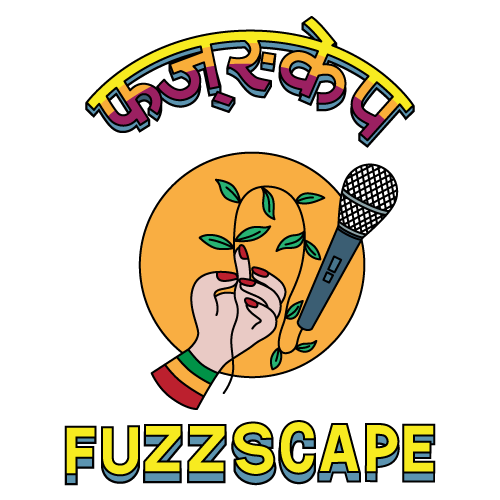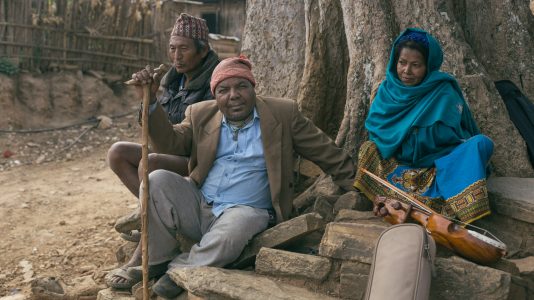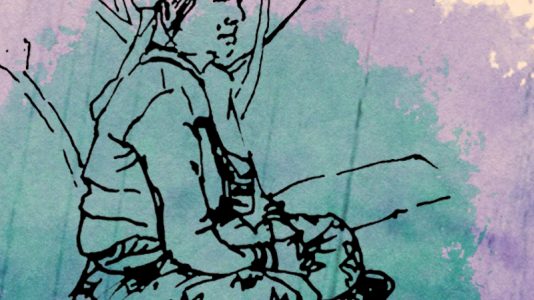Team Fuzz bumped into Mr Rai in a restaurant in Bhojpur Bajaar and through him got to know much about Bhojpur and its youth. Here’s an interview we did with him.
Growing up in Bhojpur
I was born and raised in Bhojpur. A person’s relationship with a space is affected by its condition of that time. The civil war started on the year I was born. So, there was always fear involved. Especially because my father was involved in politics and his ideology didn’t sit well with the revolutionists. But just the way filmmaker Andrei Tarkovsky puts it, irrespective of the situation of a place, the best memories are made during childhood.
I have always been an introvert and I didn’t explore much of Bhojpur growing up, but after I discovered cinema, I realised that it was important to be aware of my background and my roots. This is one of the reasons I came back to Bhojpur.
After I came back, I realised how a space, too, is a living, breathing thing. Bhojpur has now grown economically—and physically—since my childhood. But culture, I think, has shrunken to become a less significant part of our society. I am still exploring my relationship with the space.
Contemporary Cultural Practices
In the past, concerts used to be held in the community hall. Local artists used to perform songs by Narayan Gopal and Deep Shrestha. They used to play the harmonium and the tabala. A lot of street plays used to be staged as well. There was library and a lot of sports activities used to take place.
But things probably changed because the country was at war. It was tough times. The electricity went down, so did the telephone lines. Art and culture were not priorities. Then, in recent times, cultural change came about due to the growing access of technology. People found their individual sources of entertainments. You can find anything on Youtube these days. So, there wasn’t a need of community-centric entertainment anymore. So, after the war, there was no need for concerts, or street plays.
It is difficult now. It is rare to find people who play the guitar, even.
It hasn’t been long since I came back, but I came to know that a concert was organised right before I came. But it was done with more of a business motive. Also, a commercial film titled Bidesi ko Swasni was also made. Not much of cultural/artistic programmes have been held recently, though.
The Cultural Importance of Bhojpur
Bhojpur is regarded to be one of the handful of areas from where the ethnic community of Rai-Kirants originated. In remote villages like Dimma for example, ancient culture is still in practice. Considering this, Bhojpur is still quite rich, ethnically. Also, during the 2007 AD protests, people here where very active and politically aware. So, if looked at this point of history, there is a lot that can be explored as well.
Bhojpur has produced a number of individuals who have contributed a lot for Nepal. Madan Puraskar winner, Rajan Mukarung—who wrote Damini Bhir— is from Bhojpur. So is revolutionary writer Shyam Tamot. There are a few people who’ve made a difference, and I see a lot of potential in the youth of Bhojpur.
Currently Practiced Traditions and Culture
Because a majority of Bhojpur’s population is Kirants, the festival and rituals—like Sakewa, Ubhauli and Udauli—marked by the group is actively celebrated. The mangsiray puja is celebrated by the families. Also, Hindu festivals, which were promoted as state festivals after the unification by Prithivi Narayan Shah are celebrated. Even festivals of other communities, like Lhosar for example, is celebrated.
After the civil war, cultural awareness in people has been invoked. And festivals of all the communities are marked as holidays in the calendar so people know of them.
Culture in a Globalised World
Due to globalisation, different areas that had been practicing age-old cultures have slowly started to lose their cultural identities. Contemporary culture is identical wherever we go. And the fact that influence comes from so many different sources make is hard for a space to retain its age-old traditions.
If I need to learn about spirituality, for example, I go and type the word on Google. And what I get is a list of information on American spirituality practitioners. What that means is that dominant culture is influencing communities around the world. And since information from around the world is so accessible these days, it is hard to retain original identity in terms of culture.
Bhojpur and its Youth
Those who get good grades in school leave for Dharan or Kathmandu for further education. So, in a way, not all but a lot of youth currently in Bhojpur, they’re here because they don’t have a choice. And there’s a feeling of being depressed among youth here as they think they haven’t been able to do anything. That said, there are youth here who are quite active. For example, a group of youth recently organised a mela (public festival).
Cultural Infrastructure and Borrowed Identities
I believe that an individual has multiple identities. For example, during the strike in Madhes, a question was raised: “Are you Madhesi or are you Nepali?”
These multiple identities are determined by place and situation. If there should be just one identity, that should be of being a human being. In context to Bhojpur, my identity has been corrupted. The references I make, and my influences, come from cinema from other countries. I’ve been influenced by foreign filmmakers—Bhojpur didn’t have any filmmakers. Growing up, I didn’t have anybody from my ethnicity, or who shared similarities with my background to look up to. Identity for me has grown to become too complex a thing to define.
I’d hate to complain by what my guardian and my ancestors didn’t leave behind was a culture of reading good books or watching good cinema. But humans have the tendency to go on a search for what they yearn for, anyway. So, when I went about on my search, I found inspiration in the form of cinema from around the world. And this inspiration is a mixture of many things. So, at this point of time, I don’t think I am able to define my identity as one cohesive entity. That’s my situation.
The Importance of Documentation
The lack of documentation is something I’ve felt to be a problem as a filmmaker. Like I said earlier, my identity is a mixture of many things and this has not always been a choice for me.
Here’s an analogy: In grade 8, I went to this place called Golmaaraja Golmaarani Bhir, near lekharkha. There’s a myth about a king and queen of the place. In the story, the kind and the queen disappear [in physical sense] one day. There is a belief that they still dwell in the space. Unfortunately, the story is not documented anywhere. If I had access to more information regarding the place and the story, it would have been important material for me as a filmmaker to work on, but since there is nothing to start with, really, it gets difficult.
This again is connected to the idea of having an identity. It is very important to document for the sake of our identities. For example, when I went to study in Kathmandu, my friends, when I’d tell them that I was from Bhojpur, would ask me to sing Bhojpuri songs [from Bhojpuri culture and language referring to the Bihar District of India. Some cultural aspects of Bhojpur, India, is also shared by some areas in the Tarai region of Nepal.) I used to get offended at this because it would displace my sense of identity. But the problem lies here: There is no material that I can read up on about Bhojpur’s cultural history that could help me, in turn, to educate my friends. There is no documentation. No books that I can lend them, no film I could show. Even if one does not want to be confined, or associated, to a certain place and wants to claim to be a global citizen, she or he must come back home.
Cultural Reformation and Conservation
There’s always a larger goal to conserve cultural heritage, but it starts getting complicated when looked at it from the perspective of different individuals. For example, for a young Nepali man—who has finished high-school and is unemployed—how does the idea of conserving heritage fit into his life when he is going through a monetary crunch? It’ll be difficult to explain to him the importance of conservation. Economy is the infrastructure and art and culture are the superstructures.
After I came back to Bhojpur, what I found was that since most of the men are working abroad, children grow up without a father figure. Also, more than 60 % of children [in the school I teach] come from broken families. And they’re the ones who will need to face all these issues surrounding gender, class, ethnicity in the future.
When we were young, they used to say: “When Bhojpur develops, all its problems will be solved.” There is development now, but the problems persist. Relationships have become more complex now. Relationships within families face more problems.
Children who face problems from early on will develop angst against their situation and what they see around them. This angst will eventually create danger in society. The only way out is for the society to support these children to channel their angst through art, music, cinema and other forms of art. From an early age, we must let the children know that there is a path that they can take. This is my approach and I feel that cultural heritage can be preserved in this way.
Art for Society
As human being, we need to live together in a society irrespective of our individual ideals. We will eventually disagree on certain things. And I think we can express our ideas in two ways—through intellectual debate and through art. Intellectual debate only works when a person is open to ideas, and that’s the limitation of the means—acceptance is difficult for us as we are fueled with ego. But art on the other hand, affects people on a different level. It hits you when your ego has its guard down. So, forms like art, music and cinema are more relevant in a time when there are so many issues surrounding us. I believe that if children are made well-equipped with these forms of expression, then we can vouch for a better future.





